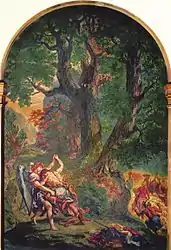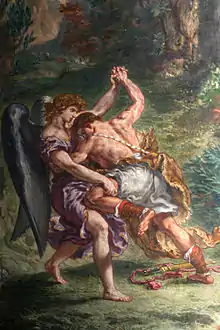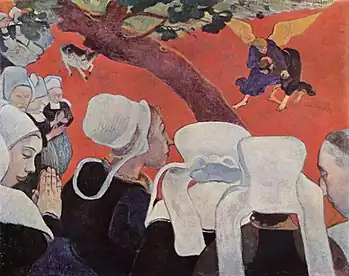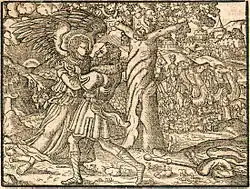Jacob wrestling with the angel
Jacob wrestling with the angel is described in the Book of Genesis (chapter 32:22–32; also referenced in the Book of Hosea, chapter 12:3–5).[1] The "angel" in question is referred to as "man" (אִישׁ: Ish) and "God" (אֵל: El) in Genesis, while Hosea references an "angel" (מַלְאָךְ: Malakh).[1][2] The account includes the renaming of Jacob as Israel (etymologized as "contends-with-God").[1]

In the Genesis patriarchal narrative, Jacob spent the night alone on a riverside during his journey back to Canaan.[1] He encounters a "man" who proceeds to wrestle with him until daybreak.[1] In the end, Jacob is given the name Israel and blessed, while the "man" refuses to give his own name. Jacob then names the place where they wrestled Penuel (פְּנוּאֵל: "face of God" or "facing God"[3]).
Hebrew Bible
The Masoretic Text reads as follows:
The same night he arose and took his two wives, his two maids, and his eleven children, and crossed the ford of the Jabbok. He took them and sent them across the stream, and likewise everything that he had. And Jacob was left alone; and a man wrestled with him until the breaking of the day. When the man saw that he did not prevail against Jacob, he touched the hollow of his thigh; and Jacob’s thigh was put out of joint as he wrestled with him. Then he said, “Let me go, for the day is breaking.” But Jacob said, “I will not let you go, unless you bless me.” And he said to him, “What is your name?” And he said, “Jacob.” Then he said, “Your name shall no more be called Jacob, but Israel, for you have striven with God and with men, and have prevailed.” Then Jacob asked him, “Tell me, I pray, your name.” But he said, “Why is it that you ask my name?” And there he blessed him. So Jacob called the name of the place Peniel, saying, “For I have seen God face to face, and yet my life is preserved.” The sun rose upon him as he passed Penuel, limping because of his thigh. Therefore to this day the Israelites do not eat the sinew of the hip which is upon the hollow of the thigh, because he touched the hollow of Jacob’s thigh on the sinew of the hip.
The account contains several plays on the meaning of Hebrew names—Peniel (or Penuel), Israel—as well as similarity to the root of Jacob's name (which sounds like the Hebrew for "heel") and its compound.[4] The limping of Jacob (Yaʿaqob ), may mirror the name of the river, Jabbok (Yabbok יַבֹּק , sounds like "crooked" river), and Nahmanides (Deut. 2:10 of Jeshurun) gives the etymology "one who walks crookedly" for the name Jacob.[5]
The Hebrew text states that it is a "man" (אִישׁ, LXX ἄνθρωπος, Vulgate vir) with whom Jacob wrestles, but later this "man" is identified with God (Elohim) by Jacob.[6] Hosea 12:4 furthermore references an "angel" (malak). Following this, the Targum of Onkelos offers "because I have seen the Angel of the Lord face to face", and the Targum of Palestine gives "because I have seen the Angels of the Lord face to face".[7]
Interpretations
The identity of Jacob's wrestling opponent is a matter of debate,[8] named variously as a dream figure, a prophetic vision, an angel (such as Michael and Samael), a protective river spirit, Jesus, or God.[9]
Jewish interpretations
In Hosea 12:5, Jacob's opponent is described as malakh, which means 'angel': "Yes, he had power over the angel, and prevailed: he wept, and made supplication to him: he found him in Bethel, and there he spoke with us". The relative age of the text of Genesis and of Hosea is unclear, as both are part of the Hebrew Bible as redacted in the Second Temple Period, and it has been suggested that malakh may be a late emendation of the text, and would as such represent an early Jewish interpretation of the episode.[10]
Moses Maimonides believed that the incident was "a vision of prophecy",[11] while Rashi believed Jacob wrestled with the guardian angel of Esau (identified as Samael),[12] his elder twin brother.[13] Zvi Kolitz (1993) referred to Jacob "wrestling with God".[14]
As a result of the hip injury Jacob suffered while wrestling, Jewish law prohibits eating the gid hanasheh (sciatic nerve), which passes through the hip socket, requiring it to be removed from meat through the process of nikkur,[15][16][17] as mentioned in the account in Genesis 32:33.[18]
Christian interpretations
The interpretation that "Jacob wrestled with God" (glossed in the name Isra-'el) is common in Protestant theology, endorsed by the Protestant reformers Martin Luther and John Calvin (although Calvin believed the event was "only a vision"),[11] as well as later writers such as Joseph Barker (1854)[19] or Peter L. Berger (2014).[20] Other commentaries treat the expression of Jacob's having seen "God face to face" as referencing the Angel of the Lord as the "Face of God".[21]
The proximity of the terms "man" and "God" in the text in some Christian commentaries has also been taken as suggestive of a Christophany. J. Douglas MacMillan (1991) suggests that the angel with whom Jacob wrestles is a "pre-incarnation appearance of Christ in the form of a man."[22]
According to one Christian commentary of the Bible incident described, "Jacob said, 'I saw God face to face'. Jacob's remark does not necessarily mean that the 'man' with whom he wrestled is God. Rather, as with other, similar statements, when one saw the 'angel of the Lord,' it was appropriate to claim to have seen the face of God."[21]
Islamic interpretations
This story is never mentioned in the Quran, but is discussed in Muslim commentaries.[23][24] The commentaries employ the story in explaining other events in the Hebrew Bible that are discussed in the Quran that have parallels, like Moses being attacked by an angel,[25] and to explain Jewish eating customs.[23][26] Like some Jewish commentators, Islamic commentators described the event as punishment for Jacob failing to give tithes to God but making an offering like a tithe to Esau.[25]
Other views
In an analysis of Marxist philosopher Ernst Bloch's 1968 book Atheism in Christianity, Roland Boer says that Bloch sees the incident as falling into the category of "myth, or at least legend". Boer calls this an example of "a bloodthirsty, vengeful God ... outdone by cunning human beings keen to avoid his fury".[27]
The wrestling incident on the bank of a stream has been compared to the Greek mythology stories of Achilles' duel with the river god Scamander[28] and with Menelaus wrestling with the sea-god Proteus.[29] It is also claimed the wrestling incident, along with other Old Testament stories of the Jewish Patriarchs, is based on Akhenaten-linked Egyptian mythology, where Jacob is Osiris/Wizzer, Esau is Set, and the wrestling match is the struggle between them.
Rosemary Ellen Guiley gives this summary:
- "This dramatic scene has spurred much commentary from Judaic, Catholic, and Protestant theologians, biblical scholars, and literary critics. Does Jacob wrestle with God or with an angel? ... There is no definitive answer, but the story has been rationalized, romanticized, treated as myth, and treated symbolically."[30]
In arts
Visual arts
One of the oldest visual depictions is in the illustrated manuscript the Vienna Genesis.[31] Many artists have depicted the scene, considering it as a paradigm of artistic creation.[32] In sculpture Jacob Wrestling with the Angel is the subject of a 1940 sculpture by Sir Jacob Epstein on display at the Tate Britain.[33] Paintings include:
 Depiction on a high cross in Kells, Ireland (10th century)[34]
Depiction on a high cross in Kells, Ireland (10th century)[34] Rembrandt (1659)
Rembrandt (1659) Eugène Delacroix (1861)
Eugène Delacroix (1861) Eugène Delacroix (1861), (detail)
Eugène Delacroix (1861), (detail) Léon Bonnat (1876)
Léon Bonnat (1876) Jacob and the Angel by Gustave Moreau (1878)
Jacob and the Angel by Gustave Moreau (1878)
 Alexander Louis Leloir (1865)
Alexander Louis Leloir (1865)
 Jacob struggles with the angel, Gutenberg Bible (1558)
Jacob struggles with the angel, Gutenberg Bible (1558) Jacob wrestles with God, 1860 woodcut by Julius Schnorr von Carolsfeld
Jacob wrestles with God, 1860 woodcut by Julius Schnorr von Carolsfeld
In music
The Latin text of Genesis 32:30 'Vidi dominum facie ad faciem; et salva facta est anima mea' (I have seen the Lord face to face) was set for the third nocturn at Matins on the second Sunday of Lent and was a popular medieval telling of the story of Jacob's encounter with the angel. It is set as the tenor (upper voice) text of Machaut's multi-text-layered Motet Vidi dominum (M 15; I have seen the Lord) simultaneously with two secular French texts: "Faux semblant m'a decü" and "Amours qui ha le pouvoir."[35] Machaut musically contrasts God's blessing in the Latin text with the disappointments of secular love in the French texts.[36] Charles Wesley's hymn "Come, O Thou Traveller Unknown", often known as "Wrestling Jacob", is based on the passage which describes Jacob wrestling with an angel. It is traditionally sung to the tune of St Petersburg.[37] U2's Bullet the Blue Sky, the 4th track on their 1987 album The Joshua Tree includes the lyric "Jacob wrestled the angel and the angel was overcome." The lyrics of Isaac, a song featured on Madonna's Confessions on a Dance Floor album, contains many allusions to the book of Genesis and references Jacob's encounter with the angel in the line "wrestle with your darkness, angels call your name". Noah Reid released his song "Jacob's Dream" as the second single of his 2020 second album.[38] The song uses the metaphor of wrestling with angels to explore that "blessings are hard to come by and they cost you something," as Reid told Indie88.[39] Mark Alburger's Israel in Trouble, Op. 57 (1997) includes the story in movement VIII. On his way.
In literature and theatre
The motif of "wrestling with the angels" occurs in several novels including Hermann Hesse's Demian (1919), Dodie Smith's I Capture the Castle (1948), Margaret Laurence's The Stone Angel (1964). In T.H. White's The Once and Future King, the Wart is described as knowing that the work of training a hawk "had been like Jacob's struggle with the angel". In poetry the theme appears in Rainer Maria Rilke's "The Man Watching" (c. 1920), Henry Wadsworth Longfellow's "Evangeline,"[40] Herman Melville's poem "Art," and Emily Dickinson's poem "A little East of Jordan" (Fr145B, 1860). In theatre, wrestling with the angel is mentioned in Tony Kushner's play Angels in America (1990); the version depicted in its miniseries adaptation is the 1865 version by Alexander Louis Leloir. Gustave Dore's image is reenacted in Jean-Luc Godard's Passion by a film extra dressed as an angel and Jerzy Radziwiłowicz.[41] Also Maud Hart Lovelace's Betsy's Wedding (1955), Stephen King's novel 11/22/63 (2011),[42] Sheila Heti's novel Motherhood (2018) and David Fennario's play Balconville (1979). A short story in Daniel Mallory Ortberg's collection The Merry Spinster (2018) explores a version of the narrative as told from the perspective of the angel.
References
- Nabulsi, Rachel (May 2023). "Rudolf Otto and the Fearful Numinous: Jacob and Moses Wrestle with the Dangerous Divine; An Investigation of Genesis 32:22-33 and Exodus 4:24-26". Biblical Theology Bulletin. SAGE Publications on behalf of Biblical Theology Bulletin Inc. 53 (2): 84–95. doi:10.1177/01461079231177689. ISSN 1945-7596. S2CID 258990435.
- John Muddiman (2007). Barton, John; Muddiman, John (eds.). The Oxford Bible Commentary (Illustrated, reprint, revised ed.). Oxford University Press. p. 577. ISBN 9780199277186.
- Strong's Concordance H6439
- A Dictionary of Biblical Tradition in English Literature, ed. David L. Jeffrey (1992). p. 852 "WRESTLING JACOB The account of Jacob wrestling with the angel at the ford of the Jabbok River is replete with Hebrew puns (Gen. 32:24–32). Several of these relate to the root of Jacob's name, 'qb ("heel"), and its compound standing as a West Semitic diminutive of "The LORD will pursue" or "The LORD preserves"
- A Dictionary of Biblical Tradition in English Literature, ed. David L. Jeffrey (1992). p. 852: "Jacob was forced to answer, Yaʿaqob, perhaps mirroring the name of the river, Yabbok, but meaning'crooked' (Nahmanides, Deut. 2:10 of Jeshurun, gives this etymology for Jacob, 'one who walks crookedly'; after the thigh wound delivered ..."
- Meir Gertner, Vetus Testamentum, International Organization of Old Testament Scholars, International Organization for the Study of the Old Testament 1960. Volume 10, p. 277: "In Genesis it is a 'man' with whom Jacob wrestled. Later in the story this 'man' appears to be identified with God (Gen. xxxii 29, 31). Talmud, Targum, Syriac and Vulgate take 'God' here to be an angel."
- Anthony Hanson The Prophetic Gospel: Study of John and the Old Testament 056704064X 2006 Page 76 "The Targum of Onkelos offers 'because I have seen the Angel of the Lord face to face',14 and the Targum of Palestine 'because I have seen the Angels of the Lord face to face'.i5 No doubt this substitution was facilitated by Hosea 12.4, where
- Green, Thomas A, ed. (2001). Martial Arts of the World: An Encyclopedia (illustrated ed.). ABC-CLIO. p. 788. ISBN 9781576071502.
- Ellens, J. Harold; Rollins, Wayne G., eds. (2004). Psychology and the Bible: From Genesis to apocalyptic vision (illustrated ed.). Greenwood Publishing Group. p. 77. ISBN 9780275983499.
- "the word is regarded as a gloss by many writers" Myrto Theocharous Lexical Dependence and Intertextual Allusion in the Septuagint of the Twelve Patriarchs
- Loades, Ann; McLain, Michael, eds. (1992). "Wrestling with the Angel: A Study in Historical and Literary Interpretation". Hermeneutics, the Bible, and Literary Criticism (illustrated ed.). Springer. pp. 133–4. ISBN 9781349219865.
- Howard Schwartz; Elliot K. Ginsburg (2006). Tree of Souls: The Mythology of Judaism (illustrated, reprint, annotated ed.). Oxford University Press. p. 359. ISBN 9780195327137.
- Shammai Engelmayer; Joseph S. Ozarowski; David Sofian (1997). Lipman, Steve (ed.). Common Ground: The Weekly Torah Portion Through the Eyes of a Conservative, Orthodox, and Reform Rabbi. Jason Aronson. p. 50. ISBN 9780765759924.
- Zvi Kolitz (1993). Confrontation: The Existential Thought of Rabbi J.B. Soloveitchik. KTAV Publishing House. p. 50. ISBN 9780881254310.
- Ze'ev Maghen (2006). After Hardship Cometh Ease: The Jews as Backdrop for Muslim Moderation (reprint ed.). Walter de Gruyter. p. 117. ISBN 9783110184549.
- John R. Kohlenberger (2004). Kohlenberger, John R. (ed.). The Essential Evangelical Parallel Bible: New King James Version, English Standard Version, New Living Translation, the Message. Oxford University Press. p. 77. ISBN 9780195281781.
- Tremper Longman; David E. Garland (2008). Longman, Tremper; Garland, David E. (eds.). Genesis-Leviticus (revised ed.). Harper Collins. p. 255. ISBN 9780310230823.
- Eli Yassif (2009). The Hebrew Folktale: History, Genre, Meaning. Indiana University Press. p. 13. ISBN 9780253002624.
- Joseph Barker (1854). Seven Lectures on the Supernatural Origin & Divine Authority of the Bible. By J. Barker. Containing his reply to the Rev. Mr. Sergeant, etc. George Turner. p. 87.
- Peter L. Berger (2014). Redeeming Laughter: The Comic Dimension of Human Experience (2, reprint ed.). Walter de Gruyter. p. 88. ISBN 9783110354003.
- Tremper Longman; David E. Garland (2008). Longman, Tremper; Garland, David E. (eds.). Genesis-Leviticus (revised ed.). Harper Collins. pp. 255–6. ISBN 9780310230823.
- MacMillan, J. Douglas (1991). Wrestling with God: Lessons from the Life of Jacob. Evangelical Press of Wales. p. 56.
- Ibn Kathir. "The Story of Ya'qub (Jacob)". The Stories of the Prophets. Retrieved 24 June 2017.
- Noegel, Scott B.; Brannon M. Wheeler (April 2010). "Jacob". The A to Z of Prophets in Islam and Judaism. Scarecrow Press. pp. 160–162. ISBN 978-1-4617-1895-6.
- Wheeler, Brannon M. (2002). Moses in the Quran and Islamic Exegesis. Psychology Press. p. 55. ISBN 9780700716036.
- Wheeler, Brannon (2002). Prophets in the Quran: An Introduction to the Quran and Muslim Exegesis. A&C Black. pp. 114–115. ISBN 9780826449566.
- Roland Boer (2007). Criticism of Heaven: On Marxism and Theology. Brill. pp. 39, 41. ISBN 9789004161115.
- Donald H. Mills (2002). The Hero and the Sea: Patterns of Chaos in Ancient Myth. Bolchazy-Carducci Publishers. pp. 145–149. ISBN 978-0-86516-508-3.
- Bruce Louden (2011). Homer's Odyssey and the Near East. Cambridge University Press. pp. 114–118. ISBN 9781139494908.
- Guiley, Rosemary E. (2004). The Encyclopedia of Angels. Infobase Publishing. p. 195. ISBN 9781438130026.
- Horst Woldemar Janson, Anthony F. Janson (2004). History of Art: The Western Tradition "The Vienna Genesis ... (In the center foreground, for example, we see him wrestling with the angel, then receiving the angel's blessing.)" [full page illustration]
- Dohna Schlobitten, Yvonne (2020). La lotta di Giacobbe, paradigma della creazione artistica. Cittadella. pp. 7–21. ISBN 978-8830817326.
- "Sir Jacob Epstein: Jacob and the Angel". Tate. Retrieved 25 June 2017.
- "Irish High Crosses: Kells"
- Anne Walters Robertson (2002). Guillaume De Machaut and Reims: Context and Meaning in His Musical Works, p. 163. "Drawn from the Genesis story of Jacob's wrestling match with the angel, Vidi dominum is a favorite phrase for theologians wishing to express their ecstasy at the moment of sight of God."
- "The text of the tenor for Machaut's motet 15 comes from the third nocturn at Matins on the second Sunday of Lent. Its biblical provenance is Genesis 32: 30. Here Jacob, after having wrestled with the angel and received both a new name (Israel) and a divine blessing, exclaims: 'Vidi dominum facie ad faciem; et salva facta est anima mea' (I have seen the Lord face to face; and my life is preserved.) Kevin Brownlee, "Machaut's Motet 15 and the Roman de la Rose: The Literary Context of Amours Qui a Le Pouoir/Faus Samblant M'a Deceü/Vidi Dominum*, in Iain Fenlon, ed. (2009), Early Music History 10: Studies in Medieval and Early Modern Music, p. 14. "The final lines of the paired poems, in which the speaker bemoans his ruin (triplum) and bad treatment (motetus) are opposed to Jacob's wrestling with the angel that lead to his blessing and re-naming as Israel...." Margaret Bent, "Deception, Exegesis and Sounding Number in Machaut's Motet 15," in Iain Fenlon, ed. (2009), Early Music History 10: Studies in Medieval and Early Modern Music, p. 25.
- "Come, O Thou Traveler Unknown". www.cyberhymnal.org. Archived from the original on 2011-10-09. Retrieved 2011-10-27.
- "Noah Reid on Instagram: "Wrestlin with angels. Aren't we all. Jacob's Dream is out now, link in bio as the kids say."". Instagram. Archived from the original on 2021-12-24. Retrieved 2020-03-29.
- "Indie88 Premiere: 'Schitt's Creek' star Noah Reid shares video for single 'Jacob's Dream' | Indie88". 12 March 2020. Retrieved 2020-03-29.
- "Longfellow: Evangeline: A Tale of Acadie, Evangeline: A Tale of Acadie".
- "YouTube". www.youtube.com. Archived from the original on 2014-05-26.
- King, Stephen (November 8, 2011). 11/22/63 (First ed.). United States: Scribner. p. 555. ISBN 978-1-4516-2728-2. Retrieved August 15, 2019.
Further reading
- Geller, Stephen A. (1982). "The Struggle at the Jabbok: the Uses of Enigma in a Biblical Narrative" (PDF). Journal of the Ancient Near Eastern Society. New Jork City: Columbia University. 14 (1): 37–60. Retrieved January 6, 2019.
{{cite journal}}: External link in|format=[I]n the context of the wrestling bout, the name implies that Jacob won this supremacy, linked to that of God's, by a kind of theomachy. [...] By prevailing over God, he has won the name 'God rules'
(p. 22).
External links
- Links to images of Jacob Wrestling with the Angel
- Jacob's Wrestling Match: Was It an Angel or Esau? (archived 20 June 2004)
- Wrestling with Angels – chabad.org